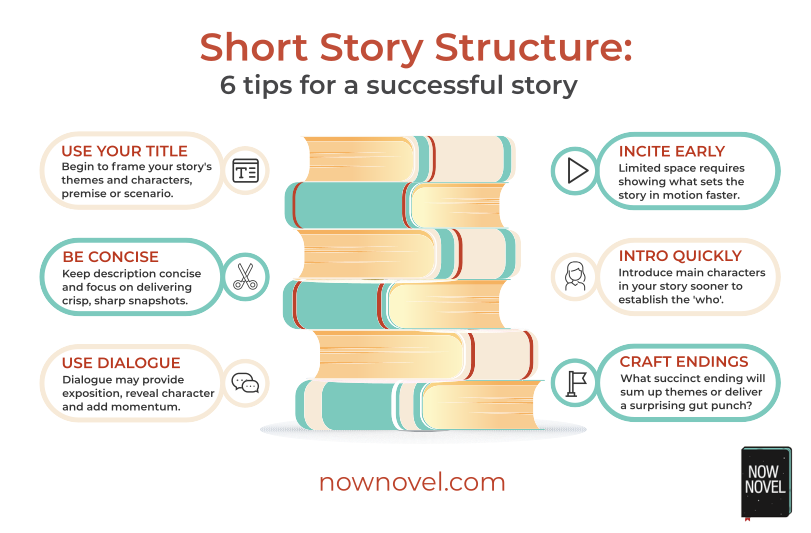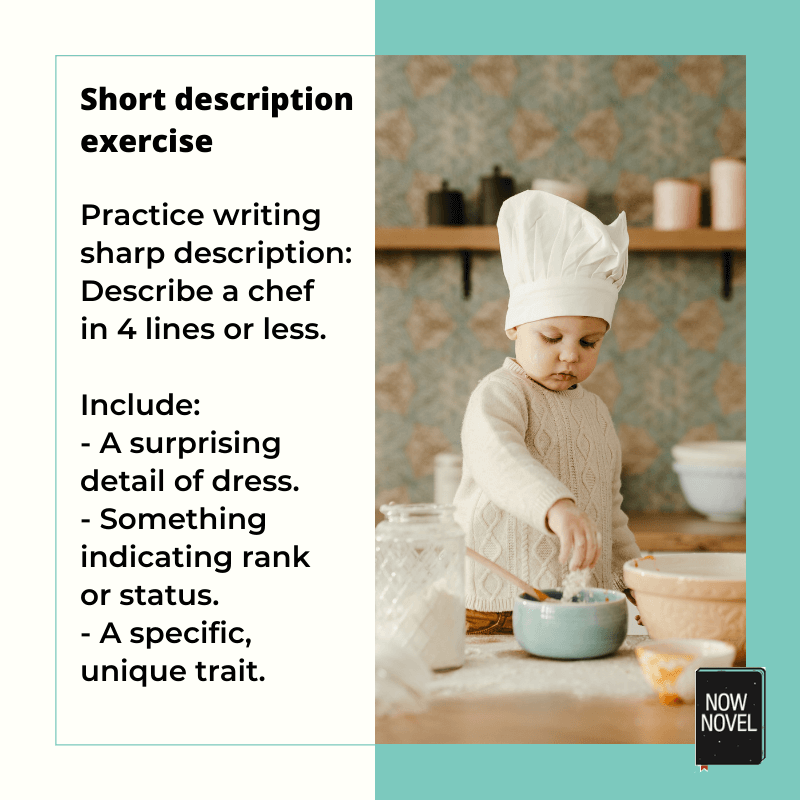Writing short stories provides a stepping stone to conquering larger story forms. Short story structure is easier to see due to brevity. Learn how to structure stories, with examples by a master of the form:
What is a short story?
A short story is any piece of fiction too short to be classified as a novel or novella. Generally, short stories tend to be under 7,500 words.
However, a short story may be shorter than this still. Gabriel Garcia Marquez’s story ‘One of These Days’ from his Collected Stories (which we’ll examine) spans two and a half pages.
Flash fiction or ‘extra short’ fiction may be only a few hundred words.
Short stories vs novels: Structural differences
There are several common structural differences between short stories and novels.
In short stories:
- There are no chapters, scene break markings such as the dinkus (***) are more rare
- Exposition (introducing the setting, characters and premise of the story) is typically more concise due to limited word counts
- Descriptions are also mostly more concise as there isn’t as much space for winding lyricism
- They typically do not have prefatory pages such as prologues, nor epilogues and other addenda
Additionally, short stories often use narrative devices associated with the form. For example, the shocking twist in the tale popularised by O. Henry.
How to make your short story structure impactful:
- Use your title to full effect
- Give an inciting incident early
- Introduce key characters quickly
- Be concise with description
- Use dialogue for momentum
- Try classic short story structure devices
- Pinpoint where to add turning points
- Outline (because it’s easier)
- Analyze classic short stories
- Create a succinct ending
Let’s unpack each of these ideas for shaping short fiction:
1. Use your title to full effect
In short stories, we’re dealing with limited space.
More meaning must be compressed into the span of a few pages, because we have less time to establish themes, characters, and the overall premise of the story.
The title of a short story thus often helps establish useful details.
Examples of titles that frame and structure short stories
For example, let’s examine a few of the titles in Gabriel Garcia Marquez’s Collected Stories:
- ‘The Third Resignation’
- ‘The Other Side of Death’
- ‘Eva is inside her Cat’
- ‘Bitterness for Three Sleepwalkers’
- ‘Dialogue with the Mirror’
- ‘Eyes of a Blue Dog’
- ‘The Woman who Came at Six O’Clock’
Each title offers something pithy about the story, whether mysteriously cryptic or straightforward.
Some suggest structure (events occurring in threes, for example, or a recurring event at a certain time of day).
In order, the first four titles tell us about:
- The character of recurring events (resignations) and their number (3).
- An unknowable situation (death) that is also a theme.
- A character (Eva) and a peculiar situation (Eva being inside her cat).
- A number of characters (the three sleepwalkers) with a shared experience (sleepwalking and bitterness).
Try to describe the revelations of the remaining short story titles listed above. What useful information does each title give, framing the story?
These are all examples of how a title already begins to shape a story. It structures your reader’s expectations.
It also leaves teasing ambiguity. For example, we might learn Eva is literally inside her cat, or rather that this is non-literal (she imagines a day through her cat’s eyes, for example).

2. Give an inciting incident early
When you’re writing a novel, you can wax lyrical and meander.
For example, the opening two pages of a novel might establish your setting. ‘It was the best of times, it was the worst of times’. And so on.
Short story structure demands that we reveal the meat of what (and who) the story is about sooner.
Let’s return to Gabriel Garcia Marquez’s collected short stories and read the first lines only of the first three stories. As you read, think about the introductory purpose of exposition.
What insights do these first lines provide regarding short story structure?
Examples of exposition in opening lines from Gabriel Garcia Marquez’s Collected Stories
Example #1 – The Third Resignation
There was that noise again. That cold, cutting, vertical noise that he knew so well now; but it was coming to him now sharp and painful, as if he had become unaccustomed to it overnight.
Marquez, Collected Stories, p. 1.
Example #2 – The Other Side of Death
Without knowing why, he awoke with a start. A sharp smell of violets and formaldehyde, robust and broad, was coming from the other room, mingling with the aroma of the newly opened flowers sent out by the dawning garden.
Marquez, Collected Stories, p. 11.
Example #3 – Eva is Inside her Cat
All of a sudden she noticed that her beauty had fallen apart on her, that it had begun to pain her physically, like a cancer. She still remembered the weight of the privilege she had borne over her body during adolescence, which she had dropped now – who knows where? – with the weariness of resignation, with the final gesture of a declining creature.
Marquez, Collected Stories, p. 20
Structurally, each group of opening lines sets out a situation for the story.
In the first and second story openings, Marquez evokes the senses. He tells his reader about unusual things characters hear or smell. These unusual sounds and smells imply underlying scenarios that remain unknown. So we read on.
In the first, a man is plagued by a cutting sound. In the second, another man smells a scent associated with death – formaldehyde, which is used in embalming corpses.
The third story opening introduces Eva of the title, and a turning point which seems to imply aging and Eva losing the looks of her youth.
Mysterious sounds or smells, stark realizations – these can all be inciting events that lead your reader into the action. Each of the above introduces a character, and we’re intrigued to learn more about what the sound is, why a man smells embalming fluid mingled with violets. What privilege Eva had, and why losing this privilege makes her feel like a ‘declining creature’.
Structure your short story well and ensure your opening:
- Introduces a situation or scenario rousing reader curiosity. What’s mysterious at this moment? What’s unknown? What would the reader love to find out?
- Gives a sense of place or character suggesting the underlying scenario. For example, a smell associated with death coming from another room (as in the second example above).
3. Introduce key characters quickly
Who are the central characters in your short story?
The sooner you introduce the main players, the sooner you can get to work developing interesting situations.
Take, for example, Marquez’s masterful short story ‘One of These Days’. It is two and a half pages long and can be read aloud in under 7 minutes:
The characters are a dental surgeon, his son, and the town’s mayor.
The story begins with Aurelio Escovar, ‘a dentist without a degree’, polishing false teeth. His son arrives, telling him, “The Mayor wants to know if you’ll pull his tooth.”
Within the first page, we have a specific character (the degreeless dentist) and an interesting dynamic (the potential of the dentist performing surgery on a person of high status).
Marquez introduces further character dynamics too, when Aurelio says to his son ‘Tell him I’m not here.’
Immediately, we wonder why he is avoiding said mayor. The next page Aurelio’s son comes back and we have the following exchange that adds further suspense to the situation:
‘Papá.’
Marquez, Collected Stories, p. 99
‘What?’
He still hadn’t changed his expression.
‘He says if you don’t take out his tooth, he’ll shoot you.’
Without hurrying, with an extremely tranquil movement, he stopped pedaling the drill, pushed it away from the chair, and pulled the lower drawer of the table all the way out. There was a revolver. ‘O.K.,’ he said. ‘Tell him to come and shoot me.’
The second third of the short story develops the tension between the characters already introduced.
This compression of story development into a page and a half is masterful. It means Marquez is able to give us precise snapshots of his characters, their scenarios, while building momentum towards their further interactions, fast.
When starting your short story, ask: What do I want the reader to know about my characters soon (for example, that the protagonist is a dentist without a degree)? What can wait?
4. Be concise with description
As we said above, novels allow expansive meandering.
Short story structure differs in description typically being concise, to the point.
For example, the simplicity of the snapshot Marquez gives us of Aurelio Escovar:
He wore a collarless striped shirt, closed at the neck with a golden stud, and pants held up by suspenders. He was erect and skinny, with a look that rarely corresponded to the situation, the way deaf people have of looking.
Marquez, Collected Stories, p. 98.
Note how Marquez combines details of dress with details suggesting status (the golden stud that closes the dentist’s shirt). He includes Aurelio’s build and posture, rounding out the description in under four lines (with highly specific descriptive details about Aurelio’s appearance’s effect).
Writing exercise: Concise description for a short story
Describe a chef in 4 lines. Include:
- A striking detail of their dress
- Something that indicates their status
- Their physique and posture (and what it suggests about their personality or relationship to their profession)
- A general detail unique to this person

5. Use dialogue for momentum
Dialogue is a wonderful gift to writers. Why? Because:
- It serves multiple purposes: Description, characterization, plot exposition
- Dialogue aids pace: We tend to digest dialogue easier than abstract narration
- It brings voice, vitality, momentum to the story
In ‘One of These Days’, we have a brilliant example of dialogue supporting short story structure.
In just 4 lines of dialogue we get:
- A sense of the dentist’s character (the terse, single word ‘What?’ in response to his son)
- A character and scenario introduction (the Mayor’s wish)
- A further complication (the dentist’s evasive instruction)
‘Papá.’
Marquez, Collected Stories, p. 98.
‘What?’
‘The Mayor wants to know if you’ll pull his tooth.’
‘Tell him I’m not here.’
The son’s later reply, the following page, develops further momentum:
‘He says you are, too, because he can hear you.’
p. 99
When including dialogue in your short stories, ask:
- What new information does this add?
- Does it develop characters or the relationships between them further and succinctly?
- Are there interesting implied tensions or conflicts dialogue could contribute?
6. Try classic short story structure devices
One of the useful things about apprenticing ourselves to masters of short stories is it’s easier to spot narrative devices.
O. Henry is famous, for example, for his stories incorporating the ‘twist in the tale’. This is a shocking revelation towards the end of a story that makes us reassess what we’ve read so far, or casts what’s occurred in a new light.
An excellent example of this is William Faulkner’s ‘A Rose for Emily’, which has a shocking twist involving strange bedfellows…
7. Pinpoint where to add turning points
Turning points are structural elements short stories and novels have in common.
What is a turning point? It is the point in a story where:
- There is a definite change (of a character’s situation, goal, consciousness – for example a sudden realization)
- There is typically a point of no return (for example, the moment the dentist Aurelio tells his son to tell the mayor to come and shoot him)
Once you know where your short story is heading, ask yourself:
- What do my characters want or fear occurring?
- What incident will make a wish or fear come true? (For example, The Mayor having an infected wisdom tooth is the catalyst for the dentist coming face to face with a tyrant in Marquez’s story)
Find turning points around characters’ goals, motivations, what they know so far compared to what they need to know (or will wish they never learned).
8. Outline (because it’s easier)
There are, of course, ‘plotters’ (who plan every minute detail of a story) and ‘pantsers’ (who see where imagination takes them). As with all categories, there are all kinds of combinations of the two.
A great gift of short story structure being smaller is that it’s easier to outline a story than a great, whopping novel.
Take Marquez’s extra-short story as a guide. Outline a two-and-a-half page story in two or three acts for practice. (News of an impending encounter leads to the encounter itself, for example.)
[Start your outline now in the free ‘Central Idea’ section of our outlining tools.]
9. Analyze classic short stories
The process we have applied above in analyzing Marquez’s short story ‘One of These Days’ is one you can apply yourself as you read.
Look for classic short stories on the shorter side. For example, the short stories of Anton Chekhov.
Create a table like this to analyze short story structure:
Title: [What situation or themes does the title imply?]
Exposition: [What do we know after the first paragraph or two?]
Description: [What do you know about place or character after the first page of this short story?]
Dialogue: [What does the dialogue reveal about the situation, characters, and other details?]
Development: [How does the opening scenario change, and what role does conflict or tension play?]
Ending: [How does the short story’s ending tie it all together?]
10. Create a succinct ending
Endings are satisfying things. Short stories give us the pleasure of getting to the send-off, the last kiss, the punchline or shocking revelation faster.
The final page of Marquez’s ‘One of These Days’ is fascinating in the way it suggests the Mayor has been a tyrant and that his tooth pain is ‘the great equalizer’. He too must face his own frailty and vulnerability.
At the start of the denoument or closing of the story, Aurelio makes a discomforting revelation:
‘It has to be without anesthesia,’ [Aurelio] said.
Marquez, pp. 99-100.
‘Why?’
‘Because you have an abscess.’
Right before he pulls the tooth, Aurelio tells the Mayor:
‘Now you’ll pay for our twenty dead men.’
p. 100.
In the final paragraphs of the story, we get a sense of how the Mayor, despite his threatening to shoot the dentist, is ultimately frail like any human and has to cede power in this situation.
Aurelio’s lines about the twenty dead men suggests the Mayor has made good on previous threats to shoot, and the pain of the extraction is a table-turning, ‘facing the reality of suffering caused others’ moment.
The succinct ending is clever. The Mayor’s final words in parting suggest a corrupt state, totalitarian power. Yet it could also be read as the mayor simply saying he doesn’t care. The mayor tries to issue a command (‘send the bill’) but Aurelio has the power to ask further questions.
‘Send the bill,’ he said.
p. 100.
‘To you or the town?’
The mayor didn’t look at him. He closed the door and said through the screen:
‘It’s the same damn thing.’
For further reading, here’s a look at how to use epilogues, denouements, afterwards, appendices and postscripts.
Read our free guide to structuring scenes for further help with endings, or get professional feedback from a skilled editor.


2 replies on “Short story structure: Shaping successful stories”
This is a good one, Jordan. Have you read much of Alice Munro’s work? She is a master. Atwood is releasing a new short collection as well: Old Babes in the Woods, Stories (set to drop in March). In that she has a gorgeous short, “My Evil Mother” that I think is more brief novella length, where the MC discovers her witch mother has been trying over the MC’s lifespan to teach her and protect her. Just brilliant.
Hi Loren, thank you! I’m glad you enjoyed it. I absolutely love Munro’s work, was just reading ‘Walker Brothers Cowboy’ from her Selected Stories this weekend. Such subtle characterization and setting creation. She really is an excellent prose stylist. I’m looking forward to the Atwood collection, need to read more of her shorts. Will look for ‘My Evil Mother’, thank you for the recommendation!